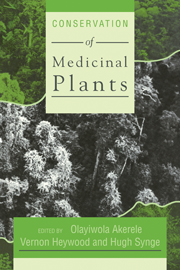Book contents
- Frontmatter
- Contents
- Contributors
- Preface
- Acknowledgements
- The Chiang Mai Declaration
- Introduction
- The Issue of Medicinal Plants
- Science, Industry and Medicinal Plants
- Techniques to Conserve Medicinal Plants
- 10 Agronomy Applied to Medicinal Plant Conservation
- 11 Biotechnology in the Production and Conservation of Medicinal Plants
- 12 Enhancing the Role of Protected Areas in Conserving Medicinal Plants
- 13 Botanic Gardens and the Conservation of Medicinal Plants
- 14 The Role of Chinese Botanical Gardens in Conservation of Medicinal Plants
- Policies to Conserve Medicinal Plants
- Experiences from Programmes to Conserve Medicinal Plants
12 - Enhancing the Role of Protected Areas in Conserving Medicinal Plants
Published online by Cambridge University Press: 07 September 2010
- Frontmatter
- Contents
- Contributors
- Preface
- Acknowledgements
- The Chiang Mai Declaration
- Introduction
- The Issue of Medicinal Plants
- Science, Industry and Medicinal Plants
- Techniques to Conserve Medicinal Plants
- 10 Agronomy Applied to Medicinal Plant Conservation
- 11 Biotechnology in the Production and Conservation of Medicinal Plants
- 12 Enhancing the Role of Protected Areas in Conserving Medicinal Plants
- 13 Botanic Gardens and the Conservation of Medicinal Plants
- 14 The Role of Chinese Botanical Gardens in Conservation of Medicinal Plants
- Policies to Conserve Medicinal Plants
- Experiences from Programmes to Conserve Medicinal Plants
Summary
Introduction
As we flew over Thailand's denuded hills, we could see visual evidence of what humanity can do to vegetation when unrestricted use is permitted. Much of this destruction of vegetation was carried out by shifting cultivators who were producing a medicinal plant, Opium Poppy (Papaver somniferum), for the international market.
But if we had flown slightly further to the west, we would have passed over the forests of the Huay Kha Khaeng Wildlife Sanctuary; and if we had flown slightly further to the east, we would have been able to look down on the lush tropical forests of Khao Yai National Park and the five protected areas of the Petchabun Range. Protected areas are more than just scenic places where tourists go to play. Because they are protected from the worst excesses of mankind, these areas often conserve significant biological resources which are of considerable use to humanity. Many such areas contain medicinal plants which are essential to medical research and practice.
It is apparent even from an aeroplane seat that the diversity of plants and animals contained in these protected areas is far greater than in the radically altered habitats that surround them. Many of the plants and animals in these forests have real or suspected medicinal value, and people frequently enter these areas to harvest species of use. Under present laws, such use is usually considered “poaching” and is punishable by fines and/or imprisonment.
Surely a better approach is required, one which will enable people to benefit in a sustainable way from the natural resources that are being conserved.
- Type
- Chapter
- Information
- Conservation of Medicinal Plants , pp. 199 - 212Publisher: Cambridge University PressPrint publication year: 1991
- 1
- Cited by



